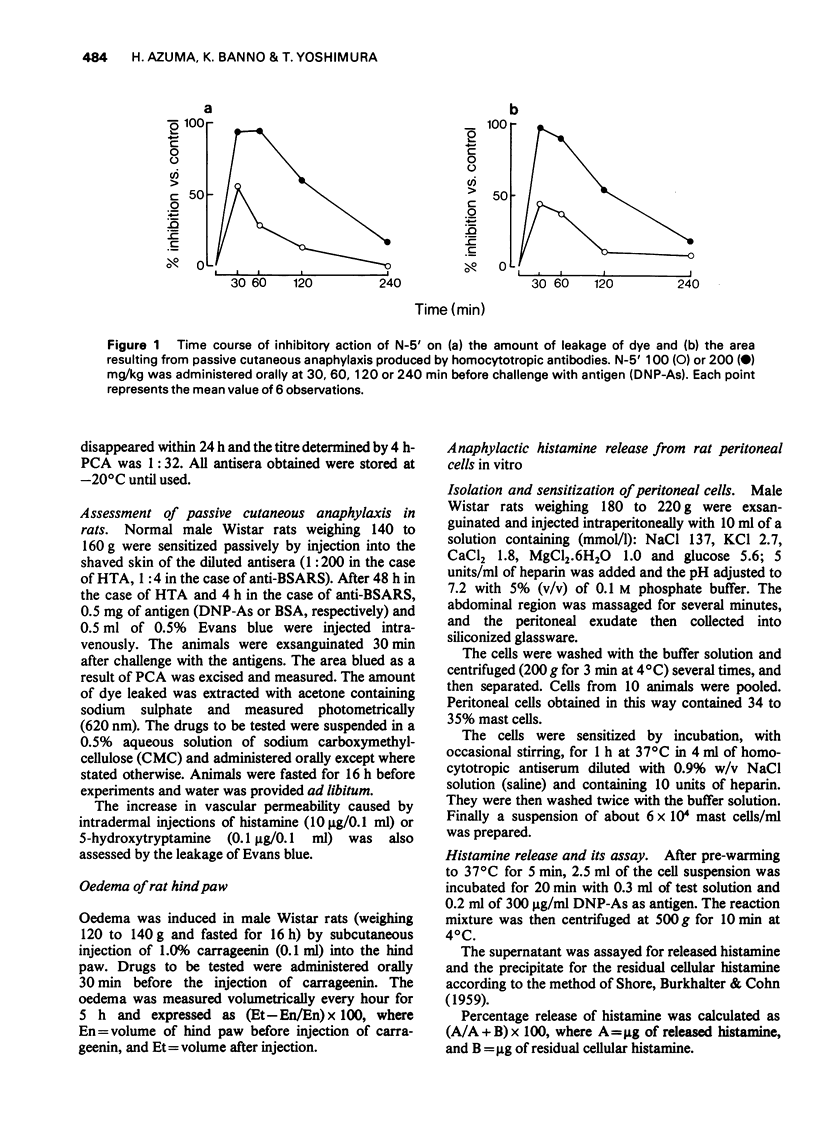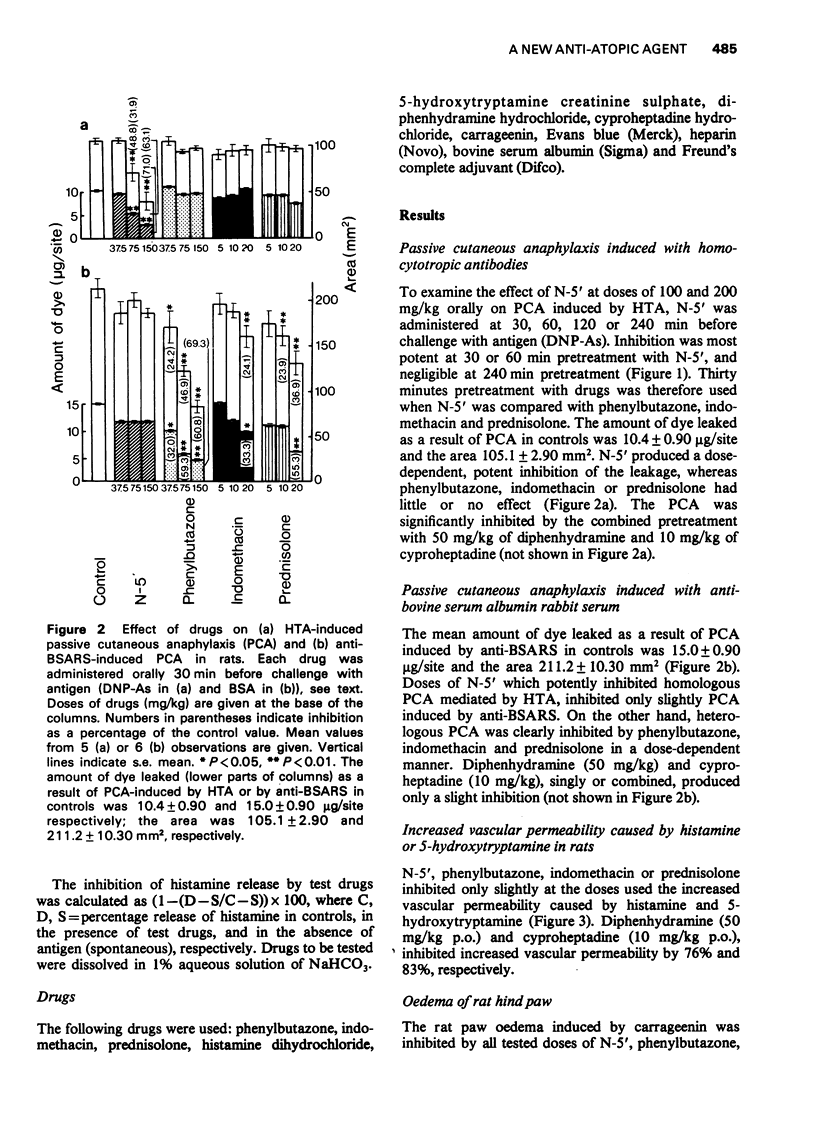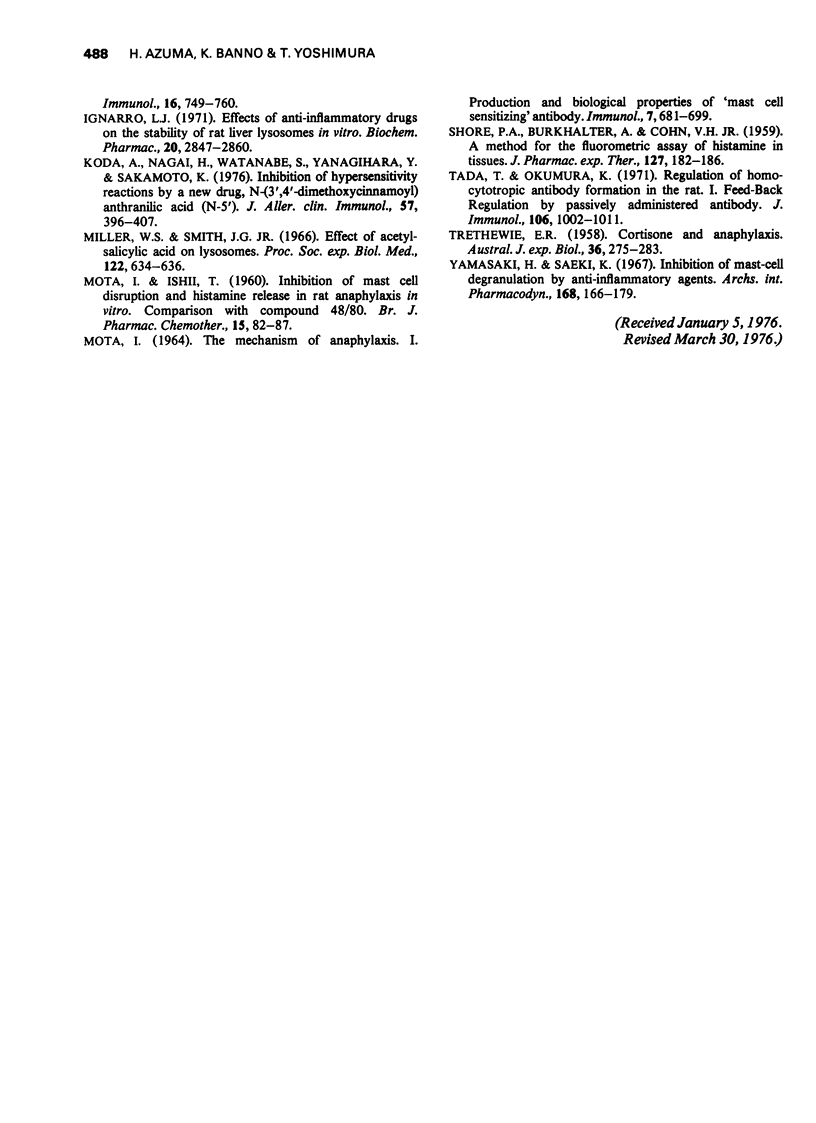Abstract
1 N-(3'-4'-dimethoxycinnamoyl) anthranilic acid (N-5') exhibited a dose-dependent, potent inhibition of the passive cutaneous anaphylaxis (PCA) mediated by homocytotropic antibodies (HTA), which was hardly affected by anti-inflammatory agents such as phenylbutazone, indomethacin and prednisolone at any dose used. The HTA-induced PCA was significantly inhibited by combined treatment with diphenydramine and cyproheptadine. 2 Doses of N-5' which potently inhibited HTA-induced PCA inhibited only slightly the heterologous PCA produced by anti-bovine serum albumin (BSA) rabbit serum. This heterologous PCA was clearly inhibited by phenylbutazone, indomethacin and prednisolone. Diphenydramine and cyproheptadine, singly or combined inhibited the heterologous PCA only slightly. 3 The increased vascular permeability caused by histamine and 5-hydroxytryptamine was significantly inhibited by diphenyldramine or cyproheptadine, but not by N-5' and the anti-inflammatory agents used. 4 N-5' 150 mg/kg orally inhibited rat paw oedema induced by carrageenin by about 26% while phenylbutazone, indomethacin and prednisolone produced significant inhibition. 5 N-5' at concentrations of 100 and 1000 muM significantly inhibited (by about 52% and 95%, respectively) the histamine release from rat peritoneal cells induced by HTA; 10 muM N-5' had little effect. Histamine release was inhibited by phenylbutazone or indomethacin at 1000 muM but not at 100 muM. Prednisolone had no effect on histamine release at any of the concentrations used. 6 These findings suggest that the inhibition of the HTA-induced PCA by N-5' may be due to inhibition of histamine release and is clearly different from the actions of anti-inflammatory agents such as phenylbutazone, indomethacin and prednisolone.
Full text
PDF





Selected References
These references are in PubMed. This may not be the complete list of references from this article.
- BINAGHI R. A., BENACERRAF B., BLOCH K. J., KOURILSKY F. M. PROPERTIES OF RAT ANAPHYLACTIC ANTIBODY. J Immunol. 1964 Jun;92:927–933. [PubMed] [Google Scholar]
- Goose J., Blair A. M. Passive cutaneous anaphylaxis in the rat, induced with two homologous reagin-like antibodies and its specific inhibition with disodium cromoglycate. Immunology. 1969 Jun;16(6):749–760. [PMC free article] [PubMed] [Google Scholar]
- Ignarro L. J. Effects of anti-inflammatory drugs on the stability of rat liver lysosomes in vitro. Biochem Pharmacol. 1971 Oct;20(10):2847–2860. doi: 10.1016/0006-2952(71)90196-1. [DOI] [PubMed] [Google Scholar]
- Koda A., Nagai H., Watanabe S., Yanagihara Y., Sakamoto K. Inhibition of hypersensitivity reactions by a new drug, N(3',4'-dimethoxycinnamoyl) anthranilic acid (N-5'). J Allergy Clin Immunol. 1976 May;57(5):396–407. doi: 10.1016/0091-6749(76)90054-3. [DOI] [PubMed] [Google Scholar]
- MOTA I., ISHIT T. Inhibition of mast cell disruption and histamine release in rat anaphylaxis in vitro. Comparison with compound 48/80. Br J Pharmacol Chemother. 1960 Mar;15:82–87. doi: 10.1111/j.1476-5381.1960.tb01213.x. [DOI] [PMC free article] [PubMed] [Google Scholar]
- MOTA I. THE MECHANISM OF ANAPHYLAXIS. I. PRODUCTION AND BIOLOGICAL PROPERTIES OF 'MAST CELL SENSITIZING' ANTIBODY. Immunology. 1964 Nov;7:681–699. [PMC free article] [PubMed] [Google Scholar]
- Miller W. S., Smith J. G., Jr Effect of acetylsalicylic acid on lysosomes. Proc Soc Exp Biol Med. 1966 Jul;122(3):634–636. doi: 10.3181/00379727-122-31212. [DOI] [PubMed] [Google Scholar]
- SHORE P. A., BURKHALTER A., COHN V. H., Jr A method for the fluorometric assay of histamine in tissues. J Pharmacol Exp Ther. 1959 Nov;127:182–186. [PubMed] [Google Scholar]
- TRETHEWIE E. R. Cortisone and anaphylaxis. Aust J Exp Biol Med Sci. 1958 Jun;36(3):275–283. doi: 10.1038/icb.1958.30. [DOI] [PubMed] [Google Scholar]
- Tada T., Okumura K. Regulation of homocytotropic antibody formation in the rat. I. Feed-back regulation by passively administered antibody. J Immunol. 1971 Apr;106(4):1002–1011. [PubMed] [Google Scholar]
- Yamasaki H., Saeki K. Inhibition of mast-cell degranulation by anti-inflammatory agents. Arch Int Pharmacodyn Ther. 1967 Jul;168(1):166–179. [PubMed] [Google Scholar]


